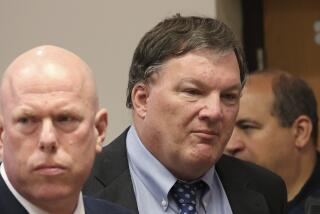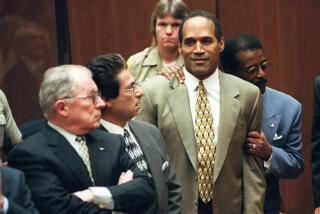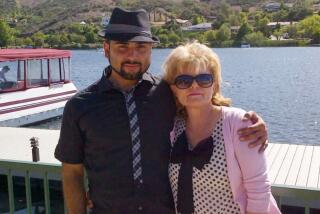Woman’s grandnephew and his Navy buddy found guilty in her 2007 slaying
The prosecutor and defense attorneys agreed on at least one thing: Sonia Rios Risken was a loathsome person.
The 60-year-old woman from Lomita was under investigation by the FBI in 2006 after her second husband, a retired naval officer, was fatally shot while visiting her relatives in the Philippines. Her first husband, a retired Marine, was shot to death 19 years earlier under suspiciously similar circumstances.
When news leaked that federal agents suspected Risken of masterminding both slayings, local media dubbed her the “Lomita Black Widow.”
Then, in a bizarre twist, Risken was killed April 26, 2007 — shot once in the back of the head — in the entryway of her home. She was wearing pajamas and a bathrobe.
On Thursday, a Torrance jury convicted Risken’s grandnephew, an active duty Navy sailor at the time of the killing, and his Navy buddy of planning and carrying out a plot to murder her.
The grandnephew, Eric Delacruz, 31, of Carson and his friend, Fernando Romero, 27, of Highland, face 50 years to life in prison. They are scheduled to be sentenced March 16.
Prosecutors alleged greed motivated the pair to kill Risken.
Delacruz, who called Risken “Grandma” and testified during trial that she practically raised him, expected to inherit her money and property, prosecutor John Lewin said during closing arguments.
“Mr. Delacruz just wanted the money that he thought was coming to him, and he didn’t want to wait,” Lewin said.
To avoid getting caught, Delacruz planned to frame Risken’s son, John Bourdeau, prosecutors alleged. In January 2007, Delacruz set up an e-mail account in Bourdeau’s name and began e-mailing the sister of Larry Risken, Sonia’s deceased second husband, authorities said.
Pretending to be Bourdeau, Delacruz e-mailed the sister and said he could retrieve her brother’s remains from the Philippines for $35,000.
In a later e-mail to her, Delacruz offered to have Sonia Rios Risken killed, also for pay, prosecutors said.
“I have a friend in L.A. and he can find a way to kill Sonia Rios Risken,” he allegedly wrote. “All I need is your permission, you don’t have to pay him right now. He will kill her first and then you can pay him later.”
That’s where Romero came into the picture, prosecutors alleged. Both sailors were assigned to the aircraft carrier Ronald Reagan at the time of the killing, and Delacruz brought Romero into the conspiracy as the “trigger man,” Lewin said.
A week before Risken’s death, someone fired a shot at her inside her Lomita hair salon. In the police report Risken filed after the shooting, she described the assailant as a Latino in his mid- to late-20s with a military haircut and light skin. That description fits Romero, prosecutors said.
Delacruz, who was at sea during the hair salon assault, had called Romero several times that day and in the days following, the prosecutor said. Then a week later, on the night of Risken’s death, cellphone records indicate that both Delacruz and Romero were in Lomita within a few miles of the victim’s house.
Risken’s body was discovered the next morning by her son, Bourdeau. A purse containing $1,700 in cash was untouched; but a 9-millimeter handgun she owned — the same caliber as the gun used to kill her — was missing.
A few days later, Delacruz went to the office of Risken’s attorney and asked “What did she leave me?” her attorney testified during the trial. It turned out Risken had no will, so much of her money went to her closest living relative — her son.
Delacruz’s attorney, Donald Levinson, conceded during closing arguments that his client was guilty of extorting the Risken family for money, but he urged jurors to consider the circumstantial nature of the evidence linking him to the slaying.
“My client is a bad guy,” he said. “But you’ve got no physical evidence that my client committed this murder.... Only phone records, some phone pings off local cell towers.”
Both Levinson and Ludlow Creary, Romero’s defense attorney, argued that detectives felt pressured to arrest the two men after the CBS crime show “48 Hours Mystery” spotlighted the case in a January 2009 episode and suggested that Delacruz was a probable suspect.
“Listen to the interviews and you can hear how frustrated the detectives are,” Levinson said. “They know Mr. Delacruz didn’t do it, but they know he knows who did.”
Sonia Rios Risken was so despicable, both defense attorneys argued, that a number of people could have committed the crime.
Levinson called Risken an “evil murderer.” Creary called her “a monster.”
The prosecutor conceded that Risken was “likely a double murderer,” but urged jurors to focus on the crime that had been committed against her.
“Our system of law is bigger than who she was,” Lewin said.
More to Read
Sign up for Essential California
The most important California stories and recommendations in your inbox every morning.
You may occasionally receive promotional content from the Los Angeles Times.











